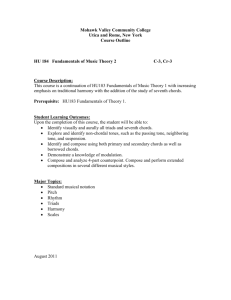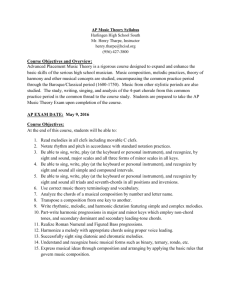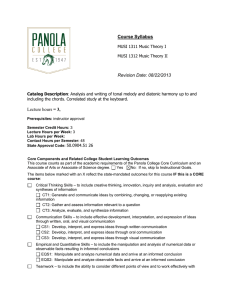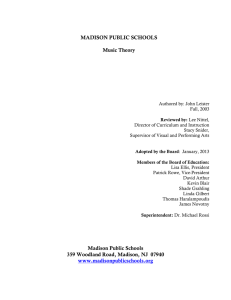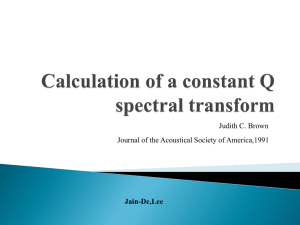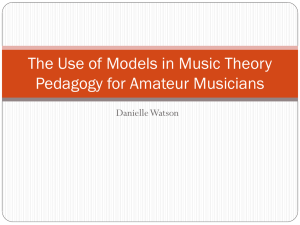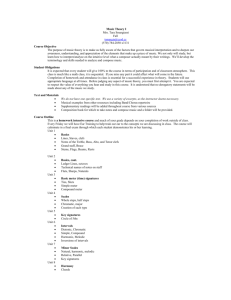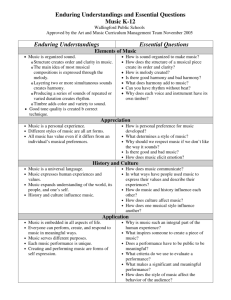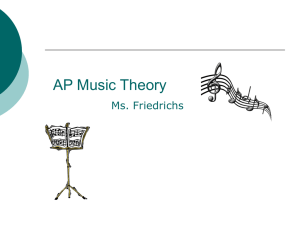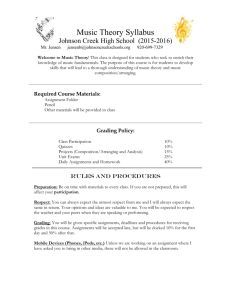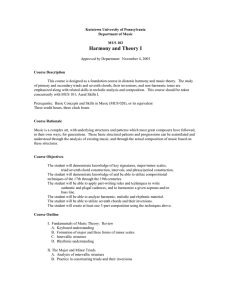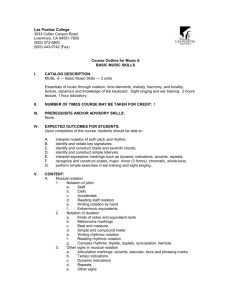AP Music Theory Course Syllabus Course Description This is a
advertisement
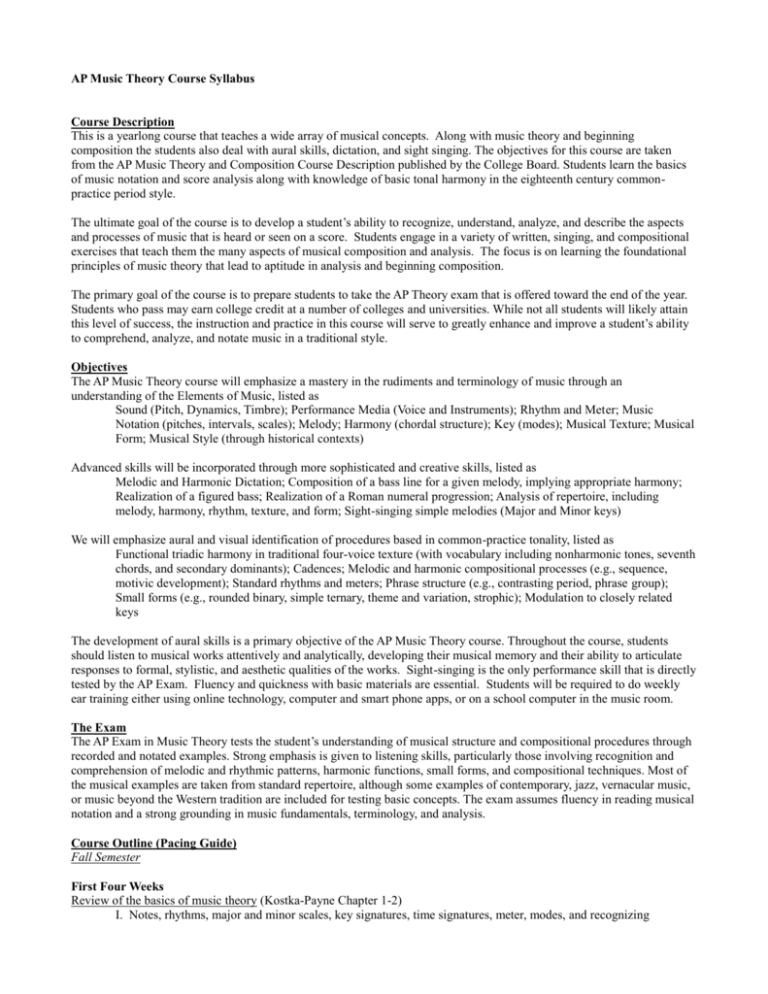
AP Music Theory Course Syllabus Course Description This is a yearlong course that teaches a wide array of musical concepts. Along with music theory and beginning composition the students also deal with aural skills, dictation, and sight singing. The objectives for this course are taken from the AP Music Theory and Composition Course Description published by the College Board. Students learn the basics of music notation and score analysis along with knowledge of basic tonal harmony in the eighteenth century commonpractice period style. The ultimate goal of the course is to develop a student’s ability to recognize, understand, analyze, and describe the aspects and processes of music that is heard or seen on a score. Students engage in a variety of written, singing, and compositional exercises that teach them the many aspects of musical composition and analysis. The focus is on learning the foundational principles of music theory that lead to aptitude in analysis and beginning composition. The primary goal of the course is to prepare students to take the AP Theory exam that is offered toward the end of the year. Students who pass may earn college credit at a number of colleges and universities. While not all students will likely attain this level of success, the instruction and practice in this course will serve to greatly enhance and improve a student’s ability to comprehend, analyze, and notate music in a traditional style. Objectives The AP Music Theory course will emphasize a mastery in the rudiments and terminology of music through an understanding of the Elements of Music, listed as Sound (Pitch, Dynamics, Timbre); Performance Media (Voice and Instruments); Rhythm and Meter; Music Notation (pitches, intervals, scales); Melody; Harmony (chordal structure); Key (modes); Musical Texture; Musical Form; Musical Style (through historical contexts) Advanced skills will be incorporated through more sophisticated and creative skills, listed as Melodic and Harmonic Dictation; Composition of a bass line for a given melody, implying appropriate harmony; Realization of a figured bass; Realization of a Roman numeral progression; Analysis of repertoire, including melody, harmony, rhythm, texture, and form; Sight-singing simple melodies (Major and Minor keys) We will emphasize aural and visual identification of procedures based in common-practice tonality, listed as Functional triadic harmony in traditional four-voice texture (with vocabulary including nonharmonic tones, seventh chords, and secondary dominants); Cadences; Melodic and harmonic compositional processes (e.g., sequence, motivic development); Standard rhythms and meters; Phrase structure (e.g., contrasting period, phrase group); Small forms (e.g., rounded binary, simple ternary, theme and variation, strophic); Modulation to closely related keys The development of aural skills is a primary objective of the AP Music Theory course. Throughout the course, students should listen to musical works attentively and analytically, developing their musical memory and their ability to articulate responses to formal, stylistic, and aesthetic qualities of the works. Sight-singing is the only performance skill that is directly tested by the AP Exam. Fluency and quickness with basic materials are essential. Students will be required to do weekly ear training either using online technology, computer and smart phone apps, or on a school computer in the music room. The Exam The AP Exam in Music Theory tests the student’s understanding of musical structure and compositional procedures through recorded and notated examples. Strong emphasis is given to listening skills, particularly those involving recognition and comprehension of melodic and rhythmic patterns, harmonic functions, small forms, and compositional techniques. Most of the musical examples are taken from standard repertoire, although some examples of contemporary, jazz, vernacular music, or music beyond the Western tradition are included for testing basic concepts. The exam assumes fluency in reading musical notation and a strong grounding in music fundamentals, terminology, and analysis. Course Outline (Pacing Guide) Fall Semester First Four Weeks Review of the basics of music theory (Kostka-Payne Chapter 1-2) I. Notes, rhythms, major and minor scales, key signatures, time signatures, meter, modes, and recognizing intervals. Basic ear training Pitch match, major interval recognition, singing major intervals, recognition of major and all minor scales. (Benward-Kolosick Unit 1) Next Two Weeks Introduction to chords (Kostka-Payne Chapter 3) I. Major, minor, diminished, and augmented triads. II. Major, minor, diminished, and half diminished Seventh chords. Ongoing ear training Identifying major and minor chords (Benward-Kolosick Unit 1) Next Six Weeks Introduction to Basic Harmony (Kostka-Payne Chapter 4-5) I. Diatonic Triads in major II. Diatonic Triads in minor III. Roman Numerals IV. Inversions and figured bass symbols for triads and seventh chords V. Voicing diatonic triads in four parts. a. Close, Open, and keyboard spacing b. Root Doubling c. Avoiding spacing and voice crossing errors VI. Voicing inverted triads in four parts. Ongoing ear training Sight singing of scalar diatonic melodies, diatonic melodic dictation (Benward-Kolosick Unit 1) Next Six Weeks The Principles of Voice Leading (Kostka-Payne Chapter 5-6) I. Rhythm, harmony, and contour of the melodic line II. Conventions regarding leaps, spacing, tendency tones, and vocal ranges III. Movement - static, oblique, similar, contrary, parallel IV. Conventions regarding parallel movement V. Smooth voice leading procedures Harmonic Progression (Kostka-Payne Chapter 3) I. Conventional harmonic progression in Major II. Conventional harmonic progression in Minor III. Roman numeral score analysis Ongoing ear training Sighting melodies with diatonic leaps, harmonic dictation with major and minor triads. (Berkowitz Chapter 1, Benward-Kolosick Unit 2) Spring Semester First Six Weeks Harmonic Functions (Kostka-Payne Chapter 8-9) I. 1st Inversion triads II. Six-four chords - the Cadential six-four, the passing six-four, the pedal six four Cadences, Phrases and Periods (Kostka-Payne Chapter 10) I. Cadences - Half, IAC, PAC, deceptive, Plagal II. Phrase Structure - identifying phrases III. Periods - Double period, parallel period, contrasting period, antecedent, consequent. Non Chord Tones (Kostka-Payne Chapter 11-12) I. Neighbor tones, passing, tones, pedal points, appogiaturas, escape tones II. Suspensions and their use. The V7 Chord (Kostka-Payne Chapter 13) I. Resolving the V7 to I II. Frustrated leading tone Realizing a Figured Bass Progression (Thomas-Horvit-Nelson Part V, Chapter 10-11) I. Review of Symbols, variations of notation Ongoing ear training Sight singing in major and minor keys, including non-chord tones, more complex harmonic dictation, error detection. (Berkowitz Chapter 2, Benward-Kolosick Unit 3-4) Next Six weeks The II7 and VII7 Chords (Kostka-Payne Chapter 14-15) I. Their resolution and use II. Other diatonic Seventh chords. Secondary Functions (Kostka-Payne Chapter 16-17) I. Secondary Dominants II. Secondary Leading tone chords III. Figured bass realization including secondary functions and suspensions Modulatory Techniques (Kostka-Payne Chapter 18-19) I. Common chord modulation II. Sequential modulation III. Other modulatory techniques. Score analysis - identifying modulations Binary and Ternary Forms (Kostka-Payne Chapter 20) I. Examples of Binary and Ternary Structures II. Score analysis - identifying forms Technical Score Analysis (Kostka-Graybil selected works) I. More in depth analysis of scores - including phrases, forms, cadences, NCT's, and modulations Ongoing ear training Introducing the free response section of the AP Test and studying approaches to it. (Released Exams) Last Six Weeks AP Review (Released Exams) I. Vocabulary Review II. Test structure and scoring III. Mock test sections. Compositional Group Project I. Groups or partners compose original pieces in 18th Century common-practice style and student ensembles perform them in class. Jazz and Twentieth Century Techniques (Kostka-Payne Chapter 27, CD Collection) I. Reading chord charts - some jazz techniques II. Introducing serialism and twentieth century composers Course Materials It is highly recommended that students use the Baron’s AP Music Theory Study Book for focusing on test skills. Kostka, S. Payne, D. Tonal Harmony: With an Introduction to Twentieth Century Music, Fifth Edition, 2004 Kostka, S. Payne, D. Workbook for Tonal Harmony: With an Introduction to Twentieth Century Music, Fifth Edition, 2004 Benward, B. Kolosick, J.T. Ear Training: A Technique for Listening, Seventh Edition, 2005 Berkowitz, S. Frontrier, G. Kraft, L. A New Approach to Sight Singing, Fourth Edition, 1997 Kostka, S, Graybill, R. Anthology of Music for Analysis, 2004 Teacher Resources Kennedy, M. The Concise Oxford Dictionary of Music, 1980 Kamien, Roger Music: An Appreciation, 9th Edition, 2007, text and accompanying CDs Kostka, S. Payne, D. Tonal Harmony: With an Introduction to Twentieth Century Music: Instructors Manual, Fifth Edition, 2004 Kostka, S. Payne, D. Set of two Compact Discs to Accompany Tonal Harmony: With an Introduction to Twentieth Century Music, Fifth Edition, 2004 The College Board. Released AP Exams 1993, 1998, 2003, 2008 Personal CD and MP3 collection of the instructor – Eric Mabrey Our High School Course Criteria Academic Literacy Plan (ALP) Our High School has adopted a school-wide learning plan for college readiness skills that are used to teach all course objectives. Students will be developing the skills found in the school's Academic Literacy Plan as follows: 1) description, give parameters which define something (what it looks, feels, or sounds like); 2) summary, extract important ideas from given source; 3) relate/apply, use learned concepts and principles in new situations; 4) analysis, break down material into component parts, 5) synthesis, put parts together to form a new whole 6) evaluation, judge the value of material for a given purpose. Habits of Mind In conjunction with the AP Standards of this course, an emphasis will be placed on developing college readiness. This will be accomplished by promoting the following “Habits of Mind” for success in college-level course work: 1) building intellectual perseverance, the persistent pursuit of knowledge, by promoting the value of a strong work ethic and cultivating sustained effort through repeated practice, 2) developing metacognition by encouraging thinking about the quality of one’s own and others’ thought processes, practicing intellectual humility, and becoming comfortable with the discomfort of ambiguity, and 3) creating intellectual curiosity by fostering a desire to know and requiring inquiry, investigation, and rigorous engagement. Grading Policy Scholarship grades are determined by cumulative points given on daily assignments, scores from tests, computer tests on ear training and music theory exercises, as well as daily participation. Grades will be kept on MyGradeBook.com. The breakdown for grades are as follows, with rounding up with a .5 or above … • A = 90%-100% • B = 80%-89% • C = 70%-79% • D = 60%-69% • F = 59% or below Citizenship grades will be determined based on daily participation, class cooperation to rules and expectations, attitude, and attendance. District policy is that 3 tardies will result in an automatic “F” grade in citizenship. Students should be aware that they are solely responsible for their behavioral choices, and academic effort. Living up to our school's standards of attendance and being on time, as well as efforts given toward class work will result in higher grades. Materials for Class Each student will need to provide the following materials … • Baron’s AP Music Theory Study Book. If unable to purchase, books are available for borrowing. • Several pencils for daily exercises. No pens allowed. • Music binder for putting daily exercises. Binders will be collected periodically for grading purposes. All assignments will need to be placed in order in the binder. • Students will need a small composition book for keeping notes on listening examples played in class. Any small composition book will be sufficient. Please, no lose papers. • A willingness to learn new, sometimes difficult music skills, with perseverance toward competence. The school will provide the following materials … • Blank staff paper for all assignments • Computer software for aural skills training and music theory training (Auralia and Musition, by Sebelius) • Computer software for composition (Finale, Band-in-a-box, Cakewalk) • Internet access to various music skills training websites Mastery Model Our High School has developed a campus wide acceptance of a mastery model. This model defines the procedures each student may take to allow for mastery of objectives for each subject. It is designed to allow students to develop their study skills toward an ability to master class objectives on initial attempts. To do this, students are given opportunities to make up units which they may have been unsuccessful in passing on their first attempt. In AP Music Theory, the student will be required to finish some practice assignments before being given a second chance to pass a failed unit test. This will ensure the student has a better understanding of the desired skills before their second attempt. Make-up testing, as well as tutoring, will be available during our school tutoring sessions on Block Days Academic Tutorial Period. All students may take advantage of this extra time in class to make-up work, do ear training, or study ahead in the curriculum. Other questions may be answered by contacting the instructor.
